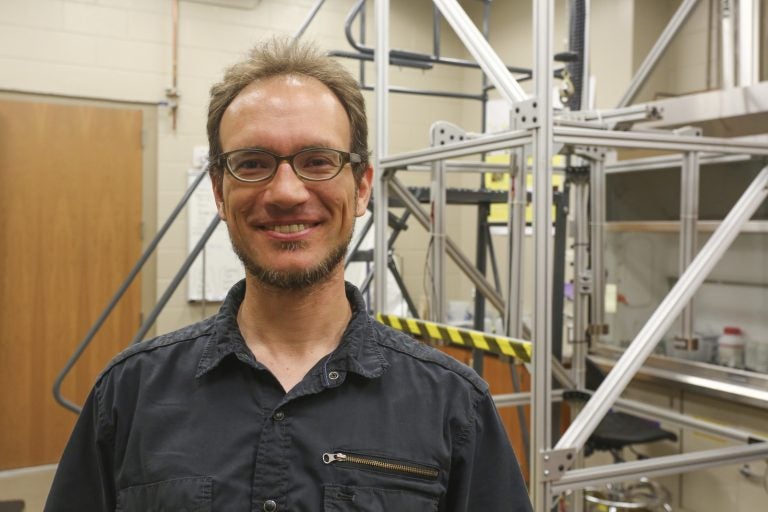The beauty of Halley’s Comet streaking through the night sky in 1986 is responsible for launching Yan Fernandez’s career, which next month puts him smack in the middle of a historic NASA mission to explore a nearby asteroid.
The University of Central Florida associate professor of physics is one of the scientists working on the OSIRIS-REx mission, a first-of-its-kind U.S. mission to retrieve a sample of a nearby asteroid. Fernandez is just as giddy about space exploration now, a month before the launch from Kennedy Space Center, as he was as a teenager growing up in Cape Coral.
“I watched Halley through binoculars,” Fernandez said. “And I was just hooked. I’d always had an interest in space, but Halley clinched it.”
He finished high school and went on to earn degrees from the California Institute of Technology and the University of Maryland in the ’90s before landing a job working at the University of Hawaii. That’s where he had routine access to some of the world’s most powerful telescopes.
“I was really lucky,” he said. “Many astronomers don’t typically get access to that much telescope time, but I did thanks to UH, and I made sure to take every opportunity to use them.”
When he moved to UCF in 2005, he joined a growing Planetary Sciences Group and met Pegasus Professor Humberto Campins, now his colleague on the OSIRIS-REx mission.
Fernandez works on multiple research projects funded by a variety of agencies including NASA, the California Institute of Technology’s Jet Propulsion Laboratory, the National Science Foundation and the Universities Space Research Association. The focus of his research is on comets and asteroids.
One of Fernandez’s favorite projects since arriving at UCF has been a survey of comets. He spent most of 2006 and 2007 leading a team of 15 other astronomers around the world gathering data from the then new Spitzer Space Telescope. The telescope, which uses infrared instead of visible light, was able to give the team a wealth of data that they continue to analyze today.
“It was really fun,” Fernandez said. “We found out so many things, things we didn’t know and things we thought we knew that we found out weren’t quite right.”
For example, most comet scientists thought nearly all the big comets that travel through our part of the solar system had been found, but the data collected suggests that there are plenty of other big comets out there waiting to be discovered.
And while spacecraft visits to a few comets had given scientists clues about what their surfaces are like, they weren’t sure about comets in general. Perhaps the surfaces of some types of comets were different. Turns out most comets do indeed have low-density, porous surfaces and “fluffy” soil, some of which they lose as they travel through space, Fernandez said.
Fernandez’s work largely involves making observations with telescopes and interpreting the data. Translation: That’s a lot of math. He can analyze streams of numbers that provide a lot of information, from the likely physical features of a comet to the likely chemical makeup.
Looking at all that data and working to solve the mystery of how comets and other space bodies work takes a lot of concentration. It’s a mental challenge that Fernandez enjoys, but he also balances those hours in front of a computer screen with time on his bicycle.
Fernandez averages about 50 miles a week commuting to UCF on his bicycle from his home in Winter Park. When the weekend hits, he is known to spend up to seven hours on runs through Central Florida including nature trials in Lake County.
“I do a lot of riding, even in the awful heat,” Fernandez said. “I’m a strict amateur, no racing for me. I do it because it feels good to be outdoors. It gives your brain time to breathe.”
Teaching is just as important to Fernandez as is the research. He teaches students each semester and also runs UCF’s Robinson Observatory. The observatory on the main campus offers academics and the general public access to the night sky. The observatory’s Knights Under the Stars program offers weekly opportunities (except for the rainy summer season) for the general public to see the night sky through powerful telescopes. Some of the events have drawn more than 200 people.
Fernandez joins students to staff those events to broaden the public’s knowledge of space. The teacher in him takes front and center when he explains to people what they are seeing through the telescope on those clear nights. His enthusiasm and passion for space especially come to life when he explains to young children what they are seeing.
He says exploring space and making discoveries is part of humankind’s DNA. That’s why he’s so excited that the OSIRIS-REx mission is finally ready to launch Sept. 8.
“I’ve been excited for a long time because OSIRIS-REx has been going for a while,” he said. “And now that it is launching, it is real. When it launches, it is time for us to really get to work. Our crunch time is when the spacecraft makes its rendezvous with asteroid Bennu.”
Fernandez will help Campins analyze data the spacecraft sends back to Earth when it arrives at the asteroid. Campins and Fernandez will look at the color and reflection of the surface of the asteroid along with other data to provide project leaders their best recommendation for where the spacecraft should pluck its sample.
“I’m excited, but the pressure is on too,” he said. “You don’t want to be the guy on the team that messes up. So I’ve been getting prepped and am ready. Can’t wait for launch.”
